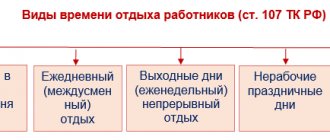How are wages paid during a shift work schedule?
Due to the nature of the work of some enterprises, they introduce a shift work schedule, in which employees work not one, but two or three shifts per day.
This regime is appropriate, for example, for enterprises in which the duration of the production process is longer than the duration of work established by labor legislation.
Also, several shifts can be introduced for more complete and efficient use of existing equipment.
In any of these cases, the question arises of how to properly organize the payment of employees and keep track of working hours. The rules and features of payment, as well as possible problems, are worth considering in more detail.
Time tracking
Moreover, this requirement applies to all employers without exception, regardless of whether they are a legal entity or an individual. The form of ownership also does not play any role.
Record keeping is carried out according to general rules using a working time sheet of the established form, in which data on all hours worked by the employee is entered. In modern conditions, there are three types of such accounting.
If you want to find out how to solve your particular problem in 2021, please contact us through the online consultant form or call :
- Moscow.
- Saint Petersburg.
Daily
Can only be used if:
- the working week consists of 5 or 6 days;
- The daily duration of the work shift is the same.
For calculations under the daily schedule, each day worked by the employee for the entire working period is taken into account.
Monday
When using this type of accounting, the length of the working day should be the same every week. The duration of an employee’s shift or daily work is regulated by the schedule.
Summarized
It is used in cases where the enterprise or organization cannot implement the daily shift duration established for specific categories of employees.
For example, such a situation may arise if an employee is unable to work less than the required 8 or 40 hours per day or week, respectively.
In this case, the maximum permissible number of hours for the entire year is calculated, and the shift schedule is drawn up in accordance with the result obtained.
As a result, it may turn out that an employee works 50 hours one week, 30 hours another, and at the end of the year the established norm is met.
If you want to find out how to solve your particular problem, please contact us through the online consultant form or call :
- Moscow.
- Saint Petersburg.
When conducting it, the employer is obliged to set the following parameters:
Length of the accounting period. It can be a month, a quarter, or a year. At the same time, for workers with normal working conditions it cannot exceed a year, for those who work in harmful and dangerous conditions - three months.
Standard working hours for various categories of citizens. It can be determined using the production calendar , which is approved annually.
Schedule. This document must also be developed and put into effect by order of the head of the enterprise. A schedule is drawn up taking into account the established norm of working hours.
The procedure for determining wages. In this case, a salary or an hourly rate can be selected.
The employer can establish summarized accounting both in relation to all employees of the enterprise, and only for certain of them. In this case, the employee must be familiar with this information by including it in the employment contract or by studying the relevant local regulatory act against signature.
Payment for a shift schedule
Wages at a particular enterprise are calculated to an employee based on the established wage system. Depending on this, it can be calculated in two ways.
At a set hourly rate
In this case, to determine the amount to be paid, it is necessary to multiply the rate by the number of hours actually worked by the employee. Data about this is taken from the time sheet maintained at the enterprise.
Example:
In this case, the number of work shifts is 8, the actual time worked is 192 hours. Therefore the salary is equal to:
Salary = 192 * 90 = 17,280 rub.
However, this amount is not the final amount, because the employee is also entitled to additional payment for night work, as well as for overtime work. The features of such an additional payment will be discussed further.
If in this example the employee worked on a “every two days” schedule, then the number of shifts and hours worked would be 10 and 240, respectively. In this case, the salary is an order of magnitude higher:
Salary = 240 * 90 = 21,600 rub.
In addition to additional pay for night and overtime work, an employee could also qualify for additional money for working on a holiday, since one of his shifts would fall on March 8. However, with such a schedule, there is a lot of overtime in excess of the monthly norm (168 hours), which is undesirable and in some cases may be prohibited by law.
In accordance with the salary established for the employee
In such a situation, it is paid in full, but provided that the employee has worked the standard hours established for the accounting period. If this standard is not met, the salary is proportionally reduced. In case of processing, an additional payment is due.
Example:
First of all, it is necessary to determine the time standard for the month in question, established using the production calendar. It is 168 hours per week, the number of working days in a month is 21 days. The employee's hourly rate is:
Emergency = 15,000 / 168 = 89.3 rubles/hour
In fact, the employee worked 16 working days. The number of hours worked in this case will be:
H = 16 * 10 = 160 hours
Since the employee did not fully work the standard time, her salary will be:
Salary = 160 * 89.3 = 14,285 rubles.
As already noted, in the event of overtime or if part of the shift coincides with night time, the employee is entitled to additional payments to his salary, the minimum amount of which is established by law.
Features of payment at night
When working in several shifts, a situation often arises in which part of the shift or its entire duration occurs at night. In accordance with Art. 154 of the Labor Code of the Russian Federation, such work must be paid at a higher rate compared to normal working conditions.
In this case, the minimum amount of additional payment is 20% of the hourly tariff rate or salary, however, it can be increased by local regulations. To account for the number of hours worked at night, you can indicate daytime and nighttime separately on the timesheet.
Payroll calculation for night work is worth considering using a separate example:
It is necessary to determine the salary for March 2021 if the employee worked 16 shifts in a month, each lasting 9 hours. First you need to determine the amount of time actually worked:
B = 16 * 9 = 144 hours
Of them:
- 112 hours - daytime (7 * 16);
- 32 hours - night time (2 * 16).
Payment for daytime hours will be:
OD = 112 * 105 = 11,760 rubles.
In accordance with the collective agreement in force at the enterprise, the additional payment for night hours is set at 20% of the hourly tariff rate. Therefore, the payment for night time will be equal to:
OH = 32 * 105 * 1.2 = 4,032 rubles.
The final salary the employee will receive will be:
Salary = 11,760 + 4,032 = 15,792 rubles.
As for additional payment for calendar days off , it is not made during shift work, since the employee has his own set schedule.
However, if he is forced to work on a day indicated in the schedule as a day off, he will also be able to claim additional payment.
Holidays and non-working days must be paid during a shift schedule according to the general rules, that is, also at an increased rate.
Overworking time: how to prevent it and what to do about it
When using a shift schedule per week, month or year, situations often arise when an employee works more than the allotted time. When developing a shift schedule and determining wages, it is worth considering the following features:
- The total duration of processing for a year should not exceed 120 hours, for 2 consecutive days - 4 hours.
- There are certain categories of citizens who are prohibited from being involved in overtime work without their consent or unless absolutely necessary. Read more about this in our other article.
- The minimum additional payment for work above the norm is:
- one and a half times the rate or salary for the first 2 hours;
- double size - for all subsequent hours.
All this must be taken into account when drawing up a shift schedule and calculating an employee’s wages.
https://www.youtube.com/watch?v=48Jfjkz2v78
If necessary, you can involve additional employees in order to distribute working time between them within the established standards.
Remuneration when an enterprise operates in several shifts has many features when compared with a regular schedule, since in this case overtime and night work often occur.
All this must be taken into account when calculating wages and making the allowances due to the employee.
When drawing up a schedule, it is necessary to focus on the established standard working hours, which will help avoid violations of current legislation.
- Moscow.
- Saint Petersburg.
Or on the website. It's fast and free!
Source: https://zakonguru.com/trudovoe/oplata/zarplata/pri-smennom-grafike-raboty.html







